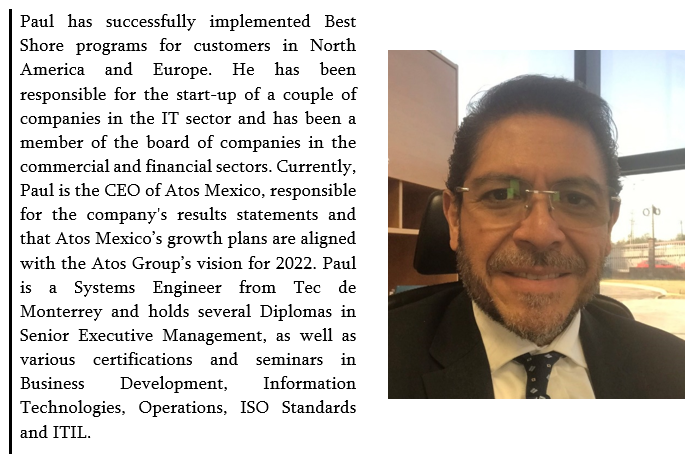At Q7 Consulting, we are aware that we live in times of uncertainty, and now more than ever Change Management and Leadership within organizations are essential concepts for success.
The people we interview are from all over the world, have outstanding career paths, have achieved success within their roles, have essential leadership traits, are influential within their organizations and have experience in implementing and managing Change.
In this sixth episode of our new series, we interviewed Paul Maya, CEO of Atos Mexico – North America who has more than 30 years of experience in the areas of Strategic Planning, Startups, Business Development, Operations and Information Technologies, with various roles and projects including business software design and development for manufacturing, transportation and retail industries. Paul has carried out the planning and startup of several large-scale Technology Centers in Mexico and South America, including all areas of technology for mission-critical infrastructure support and software development. He has also been responsible for the implementation of ISO certifications and compliance programs for different industries.

Please find below the questions and answers addressed in our interview with Paul Maya.
What have been your takeaways from managing Change?
My conclusion over the years is that Change must be constant. An organization that remains static unfortunately has a forecast of non-positive results. Changes of different levels have to be managed, both the process of continuous changes for tactical, operational day-to-day issues, such as Structural Changes that help us align the organization with new market trends.
What is your advice to people who start managing major Changes in organizations for the first time?
I recommend studying two methodologies that help a lot. The first is the best practices of project management dictated by the PMI (Project Management Institute). Which help you structure Change projects, especially for large Changes. Another methodology that also helps a lot is ITIL, which includes best practices for managing an information technology infrastructure or ecosystem. Within ITIL one of the components is precisely the management of Change. While focused on information technologies, it can be applied to any Change, especially if it is large-scale. Obviously, there are other methodologies, but I recommend starting by getting acquainted with these two.
For example, when making a change to a system, you need to make sure that you validate with all the parts where this Change has or can impact in such a way that all risks are mitigated, and the likelihood of a failure is minimized.
You also have to focus a lot on the detail. First you have to understand the Change from a macro point of view and then go to as much detail as possible of all the impact it may have, all relevant parts that may be affected or all the parts that may have relevance. All this in the end, is summarized in the best practices of the methodologies mentioned above.
What was your role in making Changes in the organization and were the Changes clearly linked to the mission and vision of the company?
I have had the opportunity to have many roles throughout my career in Change or Change Management projects, from very timely projects such as making a Change in an information system to meet new legal compliance requirements. One example I can mention is that many years ago in Mexico a temporary currency exchange was implemented for two years. The peso became new peso, and that conversion involved removing three zeros from the coin, it was further established that the new peso had to carry an “N” before the sign of the coin. This change, which we summarized in a few words, involved updating all the information systems in Mexico at a detailed level.
I have also participated in large-scale Changes, such as merging two organizations, which this becomes a portfolio of projects where each involves several Changes, such as integrating work teams, contracts, legal entities, etc.
It is essential that Change is a constant in organizations, because whenever it is growing organically or inorganically in an organization, there are always areas of improvement, areas that you have to be optimizing and to optimize them there have to be Changes. The important thing is precisely proper management of Change. What I have seen, when there is a bad experience is because the Change was not managed by carrying out best practices or there was no good communication with all relevant parties, no adequate dates were set for all the actions that had to be executed, not all the areas that should be involved were involved, or a combination of all of the above.
Carrying out good Change management will always bring positive results, which can translate into a healthy work environment, operational and financial efficiencies, among other benefits.
How did your companies support you in getting ready to lead / manage Change?
On the one hand, there have been many trainings, from the basics of Change management or project management to more advanced courses. In the different organizations I have been a part of, I have received a lot of support.
Another part that is also critical is that those who are going to manage Change must have empowerment and responsibility. If there are those two components (and a good methodology is carried out) the probability that the Change will be successful is very high.
What strategies worked and did not work to communicate the Changes and what strategy did you use to generate a sense of urgency with people?
There are several fundamental things I can recommend for this part. The first is to create a committee, regardless of whether the Change is small or large, we must ensure that all areas that must be involved are in that committee so that there is good communication and that each of the participants can extend that communication to their corresponding area. Communication should have the best clarity of Change and mainly the reason for the Change. When business reason is included in the reason for Change and why it is positive for the organization, that opens the eyes and perception of the work teams.
When you do the above, the sense of urgency is generated practically automatically, that communication must be distributed via email, internal network system, the social network that is being used within the organization, and in particular to the leaders of each of the areas. If it’s going to be something that’s going to bring efficiencies to the company and therefore the results of the organization are going to be positive, we have to emphasize it. If it is a public company, the action of this will most likely have a positive behavior.
How did you approach planning Changes? How well were the Change plans followed and how did you approach Changes to the plans?
I always recommend starting from the concept of versions. When one wants to start a Change, the first draft of the Change to be carried out is made, where we have the visibility of 80% of the impact or the relevant areas that will participate in that Change and obviously establish a cadence of review of the actions. This cadence can be daily or weekly for good monitoring. The evolution in the plans occurs automatically when an area that was not contemplated in the first draft of that project has to be involved.
What strategies did you use to attain milestones and make achievements visible?
An important thing that one has to take into account since doing the planning, is to see what is the deliverable that we will have with that Change. The key is to establish what the evidence will be that the Change was successful. The result we need to see when implementing it needs to be established, and if it is a Change through which we expect to bring improvements within 3 months or 6 months we must establish those controls to validate whether it is actually achieved. An example may be a financial efficiencies project, which we need to implement, and this includes improvement on a production line which should bring us between 5% and 10% less decline. How are we going to validate it? If my indicators are weekly or monthly, the suggestion is that at least one month’s measurement be made, and in a month we can see if the improvement was met.
The best way to give visibility to the results is with a good communication plan, backed up with a presentation before and after, as well as a summary of what was done.
What did you do to keep people committed? What did you do to keep people from going back to old ways?
Everyone’s commitment is achieved by maintaining good communication, as well as by carrying out actions to mitigate any deviations. Also, by establishing intermediate deliverables, phases to measure the implementation of Change, this is key to keeping the team engaged. It is also helpful for executive sponsors to be able to awards or perform awards on a board of directors.
To prevent people from returning to pre-Change ways, pre-Change forms must be removed. For example, in a software project, we need to make sure to delete the previous version, thus eliminating any output that allows us not to do so in the new way. Another example is, when implementing a complete purchasing system, the best way to ensure that for everything that is purchased there is a purchase order, is that if there is no purchase order there will be no payment. This ensures in the organization that the Change was fulfilled. Simply put, implement padlocks that make business sense.
Did you underestimate or overestimate what was needed to be done to achieve Change?
Initially I recommend reasonably overestimating the resources that will be needed, the people who are going to get involved, because it is easier to say that we had estimated more than was actually required in the first draft of the Change. In the next version of the Change, the estimate must already be purged so that there are also no idle committed resources or very high expenditure forecasts.
It’s always easier to delete or reduce an estimate of resources than to request additional resources.
What worked in planning and executing Changes?
Give you the right cadence for stage review or follow-up review. It’s good to start with more frequent reviews and quick tracking, and then you can decrease the frequency.
Communication is key, as transparent and assertive as possible. Many times, one has a very clear perspective on what the Change is, why this will be done and what the goal is. I recommend getting involved in preparing the communications to be made, including the files to be shared, especially when it is a very large audience or ecosystem. If hundreds or thousands of collaborators are going to be impacted, it has to be very clear communication and sent through different channels. Often email communication is sent, it is clear that inboxes fill up much faster than they are read, so you have to do it through different means: email, social network that is used in the organization, even make a group meeting or town hall when it is a key or critical project for the organization, both at startup and at completion.
